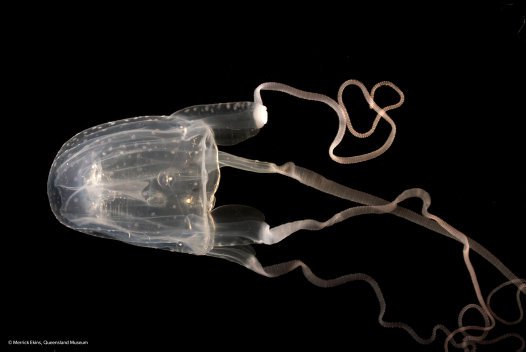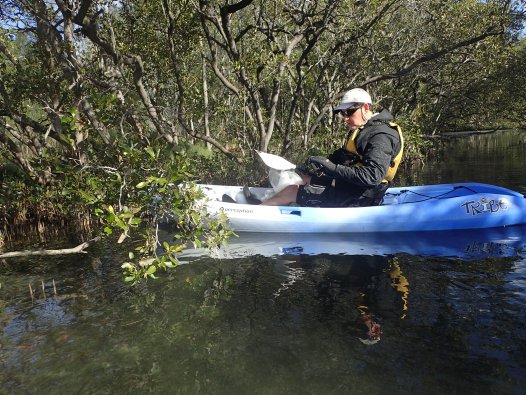A jellyfish out of the box

Morbakka fenneri, a species of box jellyfish from Queensland
Image: Merrick Ekins© Queensland Museum
During fieldwork to study the upside-down jellyfish we discovered a far more dangerous type of jellyfish in Lake Macquarie, central New South Wales, not far north of Sydney. Mistaken from a distance as a plastic bag it was soon obvious that this was an unusual species and, realising it may be something harmful, we referred pictures to our colleague Dr Lisa Gershwin at CSIRO. She rapidly identified it as a type of box jellyfish called Morbakka fenneri, commonly referred to as Morbakka or “fire jelly”. This jellyfish is found along the east coast of Australia from Port Douglas to Sydney but mostly to the north in the Moreton Bay area near Brisbane. It was a surprise to find a specimen tangled in the mangroves in Lake Macquarie as the species has rarely been recorded this far south. Additionally, it is thought to generally reside in deeper water during the day but may be attracted to the surface by lights at night.
An unexpected encounter with a box jellyfish in Lake Macquarie
Morbakka fenneri was first described by Dr Gershwin in 2008, though it was familiar to surf life savers and marine scientists before that, with the Australian Museum holding a specimen collected from Botany Bay in 1978 as well as an additional specimen from the Sydney area dating from prior to 1998. It is part of the class Cubozoa, which contains species commonly referred to as box jellyfish due to the distinctive shaped bell or umbrella that constitutes a major part of the jellyfish body. The bell of M. fenneri ranges between 6 and 18 centimetres long, with the width about half of that, giving it a rectangular appearance. The species has four broad, ribbon shaped tentacles up to a meter long, attached to each corner of the bell.
Many jellyfish have stinging cells that inject venom to stun or kill prey. The venom of M. fenneri has been documented as producing a reaction in humans that has been termed Irukandji syndrome, named by toxicologist Hugo Flecker in 1952, after the Irukandji people whose country stretches along the coast north of Cairns where jellyfish producing the reaction are common. This syndrome is known to be caused by at least 16 species of box jellyfish and has several symptoms including lower back pain, difficulty breathing, sweating, coughing, cramps and spasms, and in severe cases may cause respiratory failure, heart seizure or a stroke.

Stephen Keable filming Morbakka fenneri (a species of box jellyfish) from Lake Macquarie when it was first found
Image: Claire Rowe© Australian Museum
Protective clothing is the easiest way to prevent contact with the jellyfish. If stung by M. fenneri, the best treatment is to apply vinegar which will neutralise undischarged stingi cells. An ice pack can also be applied to the sting to reduce pain and swelling after applying the vinegar. Rubbing or applying freshwater to the area should be avoided as it will cause further discharge of stinging cells. If the patient is experiencing the severe symptoms of Irukandji syndrome such as back pain, nausea or difficulty breathing, 000 should be called as treatment can be best managed in a hospital.
As only one specimen has been found in such a large area, the level of risk is considered low, but it is important that the Lake Macquarie community is aware of the jellyfish and how best to respond if stung, so we made sure to contact the local authorities who have issued an alert. While the sighting of Morbakka fenneri inside Lake Macquarie is within the known distribution range of the species, it has been considered rare this far south, making this an exciting discovery to document. The specimen has been preserved, including samples for genetic comparison, and added to the Australian Museum Research Institute collection for future study and to provide further evidence of the southern presence of this species.
Claire Rowe, Technical Officer, Marine Invertebrates.
Stephen Keable, Collection Manager, Marine Invertebrates.
More information:
- https://www.nbnnews.com.au/2018/05/24/rare-and-dangerous-jellyfish-discovered-in-lake-macquarie/
- http://www.stingeradvisor.com/morbakka.htm
- Gershwin, L. "THE JELLYFISH APP" - available now on the App Store and Google Play in Pro version (US$1.99 / AU$2.99) and ad-supported version (free).
- Information on a related but smaller and less dangerous jellyfish common in the Sydney area, the jimble, Carybdea rastoni,.

